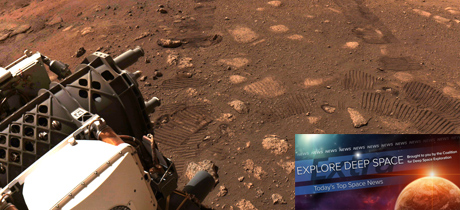In Today’s Deep Space Extra… Preparations for solar array upgrades continue at the International Space Station. Perseverance moves on Mars for the first time.
Human Space Exploration
Spacewalkers continue solar power system upgrade
CBS News (3/5): Spacewalking astronauts Kate Rubins, of NASA, and Soichi Noguchi, of the Japan Aerospace Exploration Agency (JAXA), successfully prepared two solar power channels on the International Space Station (ISS) for the upcoming addition of Roll Out Solar Arrays (ROSA) during a seven-hour spacewalk on Friday. In all, six of the ISS’s eight solar power channels are to be equipped with the new ROSAs over the coming year. The upgrade should increase the solar power generation aboard the orbiting science laboratory by about 30 percent.
ISS crew seals off first air leak in Russia’s Zvezda module
Sputnik International of Russia (3/6): Cosmonauts aboard the International Space Station (ISS) sealed off the first of two jagged cracks in the Russian segment of the Zvezda service module believed to be responsible for a small but persistent air leak. Both cracks are set to be sealed by March 12. (Editor’s note: Sputnik International is a Russian owned news source).
Space Science
In first test drive on Mars, Perseverance rover makes a short but significant trip
NPR (3/6): NASA said Friday the Perseverance rover made its first drive last Thursday, rolling forward about 13 feet, before turning to drive back about 8 feet at its Jezero Crater landing site which has now been named Octavia E. Butler Landing after the famous sci-fi author.
Nancy Grace Roman telescope is getting an upgraded new infrared filter
Universe Today (3/7): Developed to study Dark Energy and the atmospheres of exoplanets, NASA’s Nancy Grace Roman space telescope will also include a new near-infrared filter to help explore the most distant parts of the universe. The space observatory is scheduled to launch in 2025.
Officials seeking answers to Puerto Rico telescope collapse
Associated Press via ABC News (3/5): The National Space Foundation (NSF) now estimates it will cost up to $50 million to clean the debris from a succession of structural failures at the Arecibo radio telescope in Puerto Rico. The cause of the support cable failures is under an investigation by the NSF that will not be complete until late this year. In addition, the NSF has asked the independent National Academies of Sciences, Engineering and Medicine to continue an investigation into the overall collapse. Arecibo’s missions have included assessing asteroids that could pose an impact threat to the Earth and listening for possible signals from extraterrestrial intelligent life.
Other News
Lawmakers ask Biden administration to keep oversight committees in the loop on space activities
SpaceNews.com (3/6): In letters to Secretary of State Antony Blinken and Defense Secretary Lloyd Austin, U.S. Representatives Frank Lucas (R-OK) and Brian Babin (R-TX) asked for details on U.S. plans to draft language in response to a United Nations General Assembly resolution that calls for norms of behavior in space. The congressmen said they want to make sure efforts to regulate space activities are coordinated with Congress as they will have an impact on the future of U.S. government activities in space as well as on the private space sector. Rep. Lucas is the ranking member of the House Committee on Science, Space, and Technology; Rep. Babin is the ranking member of the Committee’s Space and Aeronautics Subcommittee.
Major Space Related Activities for the Week
Major space related activities for the week of March 7-14, 2021
Coalition Member in the News – Nanoracks
Spacepolicyonline.com (3/7): Virtual presentations this week include programs themed around space debris disposal and mitigation and increased diversity and inclusion in space mission leadership. The U.S. House and Senate in session, though no hearings dealing specifically with space policy are planned. On Wednesday, International Space Station (ISS) astronauts will mark the addition this year of Nanoracks’ Bishop commercial airlock. The event will air on NASA TV and stream on www.nasa.gov/nasalive at 9:05 a.m. EST.

